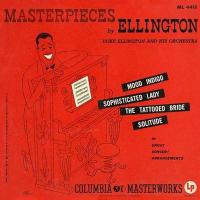Ellington Masterpieces A Record That Belongs In Every Record Collection
That's where I once found a copy of The Kinks' "Greatest Hits" double LP on UK blue label Pye Records for $2.00. I didn't buy it when it was new because? Because it was only in MONO. Stupid me. Those tunes were recorded in mono and would sound best in mono even if there were stereo mixes. Now I'd snagged a copy for $2.00. That's what record collecting fun is all about in my opinion—not paying top dollar from a dealer, though sometimes you have to.
So at another visit to this same dealer's table (or under the table to be exact), I found a copy of this Duke Ellington album about which I knew nothing. For $1 I didn't bother to read the notes. I just checked the condition and it was very good but I did notice one odd thing: it was on the green Masterworks label. Even if it was a collection of 78rpm transcriptions I didn't care. The cover art by a "Stan Fraydas" alone made it worth a buck.
I cleaned it when I got home and played it. Within the first minute even before I had a chance to read the liner notes, I remember saying "Holy Shit! What is this?????"
This record from 1951 is one of the finest sounding jazz records you will ever hear. More about that shortly, but more importantly, this record is among the most significant LPs ever released because it was among the first to allow a genius like Duke Ellington to fully express himself on record.
Until the advent of the LP recording artists were limited to three minutes. Ellington in concert played long, extended suites not three minute dance tunes. This record was his first opportunity to let listeners hear at home what his orchestra played in concert.
Magnetic recording tape had come to America from Germany after WWII brought here by Jack Mullin and popularized by Bing Crosby who put $50,000 into a small company called Ampex (the story is best told elsewhere.
Two years after the introduction of the long playing record, in December of 1950 Columbia Records brought Duke Ellington and his orchestra into its 30th Street Studios to record to magnetic recording tape using an AMPEX 200 threaded with 3M 111 recording tape. At the board were the legendary recording engineer Fred Plaut and Harold Chapman.
Ellington and his band performed 11 minute plus versions of three signature compositions: "Mood Indigo", "Sophisticated Lady" (with vocal by Yvonne Lanauze) and "Solitude". It marked the debut of what would become another Ellington classic "The Tattooed Bride".
Allowed to stretch out, Ellington's arrangements put you in the lap of musical luxury aided by a recording that is so rich, deep and harmonically well-saturated you may well have trouble handling all of the riches in a single sitting. That is how overwhelmingly spectacular are both the music and the sound. The clarinet on "Mood Indigo" just about lands in your lap. If you don't think mono produces depth, listen to this.
For this reissue Chad Kassem insisted upon the original 15IPS master tapes, which were in remarkably great condition. Ryan K. Smith cut lacquers at Sterling Sound and of course plating and pressing was done at QRP.
Kassem used the original artwork (the album was later reissued using more "modern" graphics) by Stan Fraydas (better known in some circles as author of "Hoppy, the Curious Kangaroo") adding gorgeous black and white session photos (or photos from some Ellington 30th Street Studios session) on the inner gatefold jacket, which is "tip on" paper on cardboard from Stoughton Press.
Mine was a test pressing but I think the only thing Kassem missed was using the original green Columbia Masterworks label. Not a big deal.
Most highly recommended (the record is now on the QRP presses). It's one of my "Records to Die For" in the February 2015 Stereophile. You won't have to die to get a copy. $30 will do and it's well worth the money. A true classic both musically and sonically and a historical work of art you can now own.
(Review written and posted at 30,000 feet on a WiFi enabled United 737).



